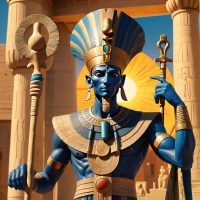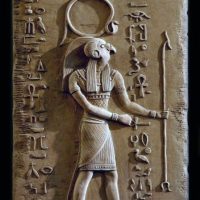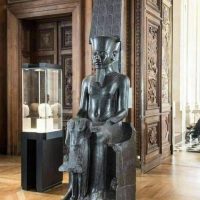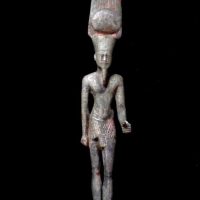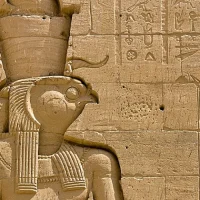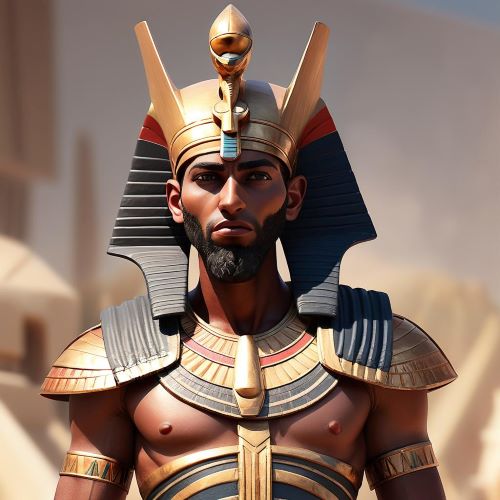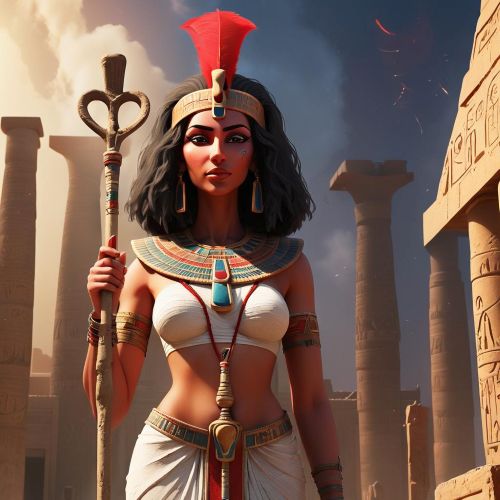Amun Ra : King of Gods
Listen
At a glance
| Description | |
|---|---|
| Origin | Egypt Mythology |
| Classification | Gods |
| Family Members | Mut (Wife), Khonsu (Son) |
| Region | Egypt |
| Associated With | Supreme Powers |
Amun Ra
Introduction
Amun Ra occupies a central place in the mythology and religion of ancient Egypt. His identity is the product of a powerful fusion between two gods: Amun, the hidden god of Thebes, and Ra, the sun god of Heliopolis. Amun began as a local deity associated with fertility and the unseen forces of the air, while Ra was the great solar deity responsible for creation, light, and the cycle of life. As Thebes rose to prominence during the Middle and New Kingdoms, Amun merged with Ra, creating Amun Ra, the supreme god of Egypt. He became both the hidden and the revealed, the invisible wind that sustained existence and the blazing sun that illuminated the world. His worship flourished for centuries, making him one of the most enduring and influential figures in the ancient Egyptian pantheon.
Physical Traits
The depictions of Amun Ra reflect his dual heritage and his many roles within Egyptian cosmology. In human form, he is usually shown as a bearded man wearing a tall headdress crowned with two long feathers. This regal imagery highlighted his sovereignty and connection with the sky. As a symbol of virility and creation, he could also take the form of a ram or a ram-headed man, the ram itself being an animal sacred to his cult.
At times, his fusion with Ra was emphasized by portraying him with the head of a falcon crowned by a solar disk encircled with a cobra, signifying protection and eternal power. Some temple murals even presented him with blue skin, a color symbolizing the life-giving force of the air and the primordial waters of creation. These varied artistic depictions reinforced the idea that Amun Ra was both visible and invisible, capable of existing in multiple forms at once. His sacred symbols included the ankh, representing eternal life, and the was-scepter, embodying authority and divine order.
Family
The mythological family of Amun Ra reveals his position within the broader Egyptian religious system. As Amun, he was often described as self-created, emerging from the primordial waters of Nun to shape the universe. Yet he was also integrated into the Theban Triad, which consisted of himself, his consort Mut, and their son Khonsu. Mut embodied maternal strength and royal protection, while Khonsu was the moon god, associated with healing, time, and renewal.
This triad was celebrated in great religious festivals, most notably the Opet Festival, where the statues of Amun, Mut, and Khonsu were carried from Karnak to Luxor in magnificent processions. These ceremonies reinforced the bond between the divine family and the ruling pharaoh, who was seen as Amun Ra’s earthly representative. Through these associations, Amun Ra symbolized both the origins of creation and the continuation of divine order through family and kingship.
Other names
Amun Ra’s many names and titles illustrate his widespread worship and syncretism with foreign cultures. The name Amun means “the hidden one,” emphasizing his mysterious, unseen essence. When combined with Ra, he was called “Amun Ra, King of the Gods,” reflecting his supremacy over all other deities. Egyptians also referred to him as “Kamutef,” meaning “bull of his mother,” a title linked to his creative and regenerative powers.
As Egyptian influence spread, his identity was absorbed into other cultural systems. In Greece, he was known as Zeus Ammon, and in Rome as Jupiter Ammon. Both names show the way Hellenistic and Roman rulers equated their own chief gods with Amun Ra to legitimize power. Spellings of his name vary across texts, including Amon, Amen, Ammon, and Hammon. Each variation points to his lasting reach across the Mediterranean world, where his cult became a bridge between Egyptian traditions and wider ancient belief systems.
Powers and Abilities
Amun Ra was revered as a god of immense creative power and universal authority. As the hidden Amun, he embodied the unseen breath of life, the wind that sustains all beings. As Ra, he was the radiant sun, the visible source of light, growth, and prosperity. Together, Amun Ra encompassed the totality of creation: the invisible force and the visible manifestation of life. He was considered the father of the pharaohs, with many rulers claiming divine birth through him. This connection reinforced his role as the protector of kingship and guarantor of victory in war.
His creative powers were said to have brought forth not only humanity but also the gods themselves. He maintained cosmic balance, ensuring the continuation of Ma’at, the principle of truth and harmony. Unlike some gods whose worship was reserved for the elite, Amun Ra was accessible to ordinary Egyptians, who saw him as a protector of the poor and a source of justice. His temples were centers of oracles, healing, and divine guidance, further cementing his role as a god who shaped destinies. The power of his name was considered so great that to know it fully was thought to be dangerous, underscoring his association with mystery and awe.
Modern Day Influence
The legacy of Amun Ra extends far beyond the fall of ancient Egypt. His great temple at Karnak remains one of the most visited and studied archaeological sites in the world, drawing millions who are fascinated by the grandeur of his cult. The Siwa Oasis oracle, where Alexander the Great was declared the son of Amun, demonstrates how his influence shaped both Egyptian and foreign rulers’ claims to legitimacy. Greek and Roman interpretations of him as Zeus Ammon and Jupiter Ammon highlight his integration into classical religion and art, ensuring that his worship lived on outside Egypt.
In modern culture, Amun Ra appears frequently in literature, films, and video games, where he often symbolizes hidden wisdom, immense power, or divine kingship. Neo-pagan and esoteric traditions have also revived his image as a source of spiritual strength and universal creation. Scholars continue to analyze his role in the development of religious thought, noting how his fusion of hidden and visible divinity foreshadowed later concepts of an omnipresent, all-powerful deity in monotheistic traditions. His presence in global imagination underscores the timeless appeal of a god who was both mystery and light, protector and creator, eternal and universal.
Related Images
Source
Baqai, Y. (2018). The Power of Amun-Ra. Chapman University Digital Commons. https://digitalcommons.chapman.edu/cusrd_abstracts/298/
Hart, G. (2005). The Routledge Dictionary of Egyptian Gods and Goddesses (2nd ed.). Routledge.
Pinch, G. (2002). Egyptian Myth: A Very Short Introduction. Oxford University Press.
Shaw, I. (Ed.). (2003). The Oxford History of Ancient Egypt. Oxford University Press.
Ancient Egypt Online. (n.d.). Amun | Amon-Ra | The King Of The Egyptian Gods. https://www.ancient-egypt-online.com/amun.html
Egyptian Museum. (n.d.). Amun – Explore Deities of Ancient Egypt. https://egyptianmuseum.org/deities-amun
World History Encyclopedia. (2016). Amun. https://www.worldhistory.org/amun/
Mythopedia. (2022). Amun. https://mythopedia.com/topics/amun/
Frequently Asked Questions
What is lorem Ipsum?
I am text block. Click edit button to change this text. Lorem ipsum dolor sit amet, consectetur adipiscing elit. Ut elit tellus, luctus nec ullamcorper mattis, pulvinar dapibus leo.
What is lorem Ipsum?
I am text block. Click edit button to change this text. Lorem ipsum dolor sit amet, consectetur adipiscing elit. Ut elit tellus, luctus nec ullamcorper mattis, pulvinar dapibus leo.
What is lorem Ipsum?
I am text block. Click edit button to change this text. Lorem ipsum dolor sit amet, consectetur adipiscing elit. Ut elit tellus, luctus nec ullamcorper mattis, pulvinar dapibus leo.
What is lorem Ipsum?
I am text block. Click edit button to change this text. Lorem ipsum dolor sit amet, consectetur adipiscing elit. Ut elit tellus, luctus nec ullamcorper mattis, pulvinar dapibus leo.
What is lorem Ipsum?
I am text block. Click edit button to change this text. Lorem ipsum dolor sit amet, consectetur adipiscing elit. Ut elit tellus, luctus nec ullamcorper mattis, pulvinar dapibus leo.


